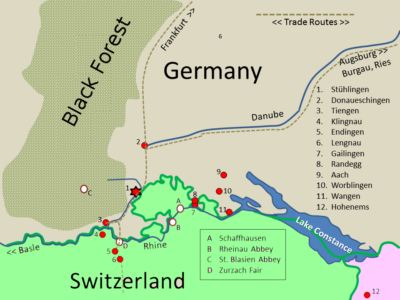3. The Neighborhood
¶ 1 Leave a comment on paragraph 1 0 The Upper Rhine and Lake Constance largely form the border between southern Germany and Switzerland. But near Basel and Schaffhausen, Switzerland extends north of the Rhine. The three Swiss exclaves of Rafz, Schaffhausen, and Ramsen create a very complex boundary pattern between the two countries (see fig. 4).
¶ 2
Leave a comment on paragraph 2 0
 Figure 4. Map of Region from Black Forest to Lake Constance. Jewish Communities in Locations 1 – 12
Figure 4. Map of Region from Black Forest to Lake Constance. Jewish Communities in Locations 1 – 12
¶ 3 Leave a comment on paragraph 3 0 The town of Stühlingen is situated between the eastern foothills of the Black Forest and the northwestern border of Schaffhausen on the western bank of the little Wutach River. For most of the seventeenth and eighteenth centuries Stühlingen was ruled by the counts of Fürstenberg from their capital Donaueschingen to its north. The little town of Tiengen – now Waldshut-Tiengen – lies near the confluence of the Wutach and Rhine Rivers. Both Tiengen and Donaueschingen had interacting Jewish Communities.
¶ 4 Leave a comment on paragraph 4 0 Jewish life in Stühlingen was also impacted directly by the city of Schaffhausen, the capital of the Swiss canton with the same name. Schaffhausen, situated just above the Rhine Falls, was notorious for its less than hospitable treatment of Jews.1 Of the two neighbouring Benedictine monasteries, Rheinau on a small island in the Rhine and St. Blasien in the Black Forest, the latter affected the Jews of Stühlingen much more directly, since the early Jewish trade from Stühlingen was largely directed towards holdings of St. Blasien.2 But the little town of Zurzach with its important biannual fairs was probably the most important magnet for commercial Jewish life in the region.3
1Löwenstein, Geschichte der Juden.
2Kopialbuch des Klosters St. Blasien.
3Guggenheim-Grünberg, “Die Juden auf der Zurzacher Messe.”

Comments
0 Comments on the whole Page
Login to leave a comment on the whole Page
0 Comments on paragraph 1
Login to leave a comment on paragraph 1
0 Comments on paragraph 2
Login to leave a comment on paragraph 2
0 Comments on paragraph 3
Login to leave a comment on paragraph 3
0 Comments on paragraph 4
Login to leave a comment on paragraph 4
0 Comments on paragraph 5
Login to leave a comment on paragraph 5
0 Comments on paragraph 6
Login to leave a comment on paragraph 6
0 Comments on paragraph 7
Login to leave a comment on paragraph 7